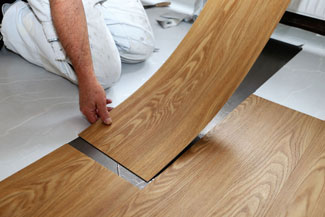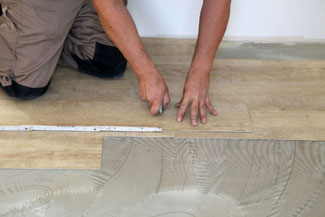Luxury Vinyl Installation
KEEP A CONSTANT TEMPERATURE.
The floor covering, adhesive, and room temperature must be kept within a temperature range of 65-100 degrees for at least 48 hours before installation and 48 hours after installation. In certain cases where the epoxy adhesive is used, the temperature should not exceed 85 degrees. The flooring material should be allowed to acclimate to the temperature of the area in which it will be installed for at least 48 hours in advance.
A PREPARED SUBFLOOR MAKES FOR A BETTER INSTALLATION.
Start with a clean job site, a prepared subfloor, and remove any items that may damage the flooring during installation. Substrates must be dry, clean, smooth, and free from paint, varnish, wax, oils, solvents, and adhesive from former flooring. A properly prepared subfloor is important because the wrong type can telegraph through the new floor. This will not only be unattractive, but it will cause uneven wearing. Underlayment panels are intended to provide a smooth working surface but are not designed to correct or properly cover structural deficiencies.
Some types of nails, such as common steel nails, cement coated, or some resin or rosin coated nails may cause a discoloration of the vinyl floor covering. Use only non-staining fasteners with underlayment panels.
A PRECISE LAYOUT WILL CREATE A BEAUTIFUL FLOOR.
Precise measurements must be taken during the layout. Your installers will lay out the tiles with all directional arrows pointing in the same direction. With a plank layout, it is also important to balance the layout of the plank format. Proper planning and layout will prevent narrow plank widths at wall juncture. Your installer will accurately measure the room to determine the center line, adjust this established line to accommodate a balanced layout and then transpose this line to a comfortable width away from the starting wall. An adhesive will be applied in this area and the planks will begin to be installed. The manufacturer’s recommended adhesive should always be used in order to maintain the manufacturer’s warranty.
When determining the proper layout for mixing tile and planks for custom installations, it is important to consider overall pattern and concept before getting started. The pattern should be carefully calculated and laid out for a successful installation.
AFTER INSTALLATION DAY.
When the installation is complete most floors must be rolled with a minimum 100-pound three-section roller immediately after installation. The installer will roll the flooring in both directions to firmly seat the tile into the adhesive.
After installation, furniture and foot traffic should not be on the floor for at least 24 hours. This allows for the adhesive to dry completely. The floors should also not be washed for 48 hours after installation. The adhesive residue on the floors can be removed with mineral spirits. Floor covering subjected to excessive heat and light exposure is subject to thermal degradation. Use appropriate precautions to minimize the potential effects on the floor covering. Oil and petroleum-based products can result in surface staining.







